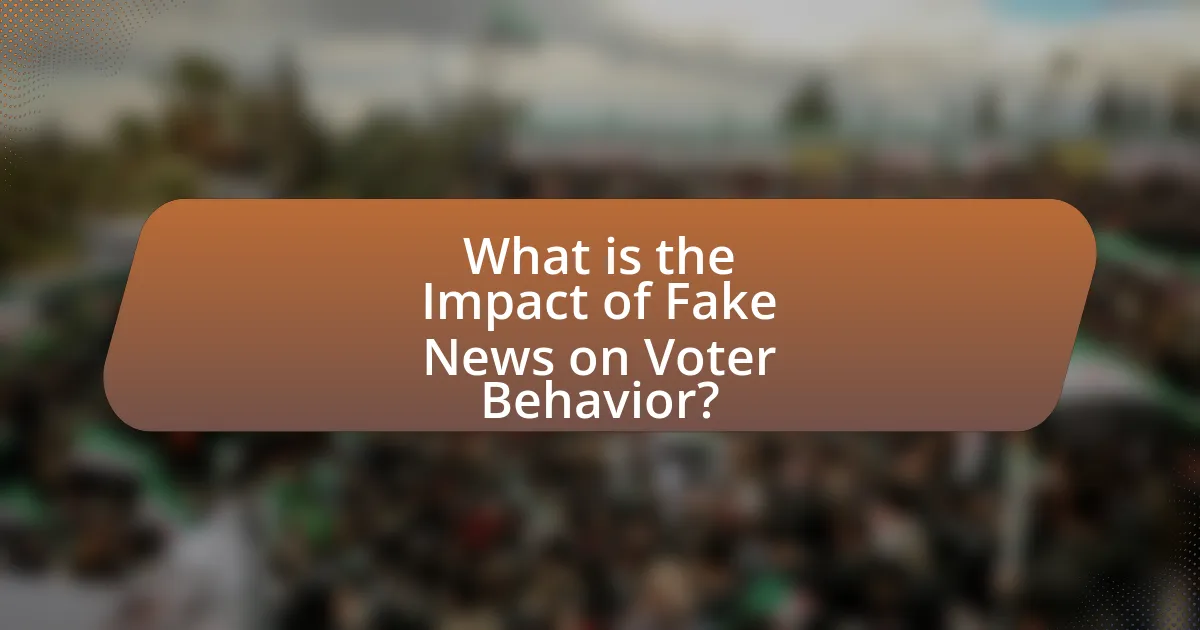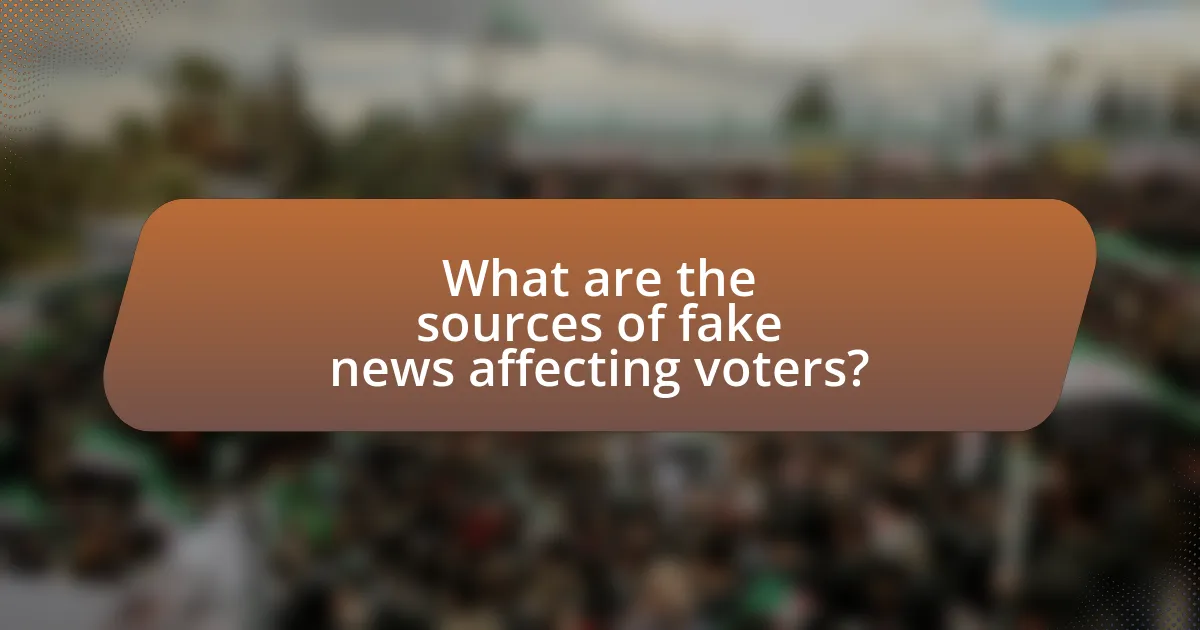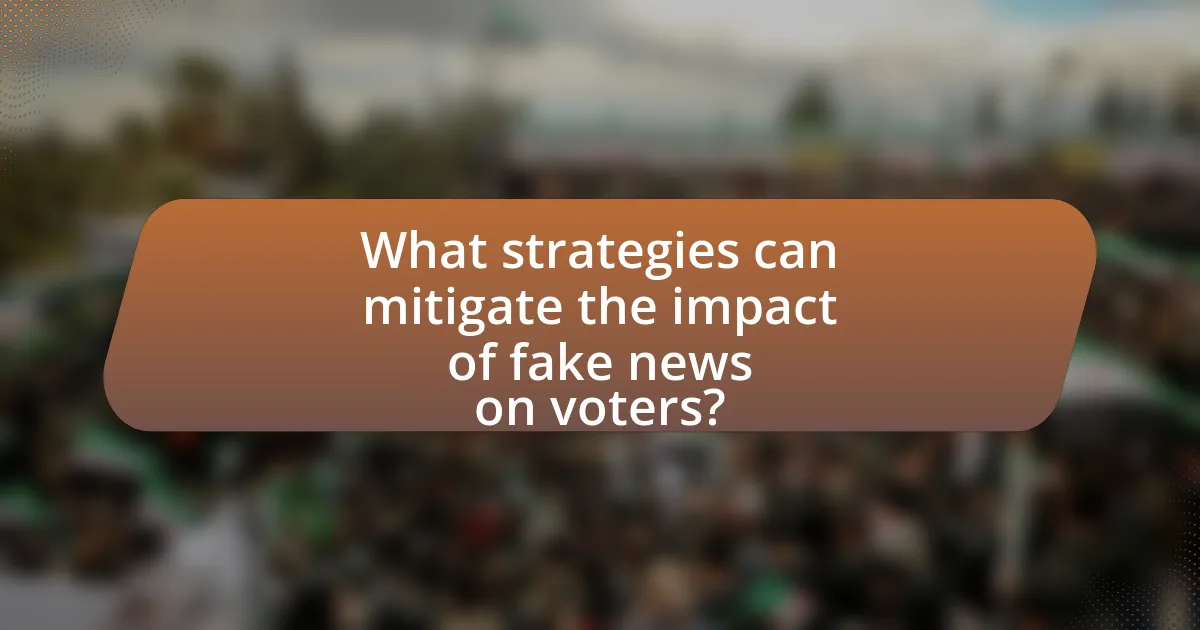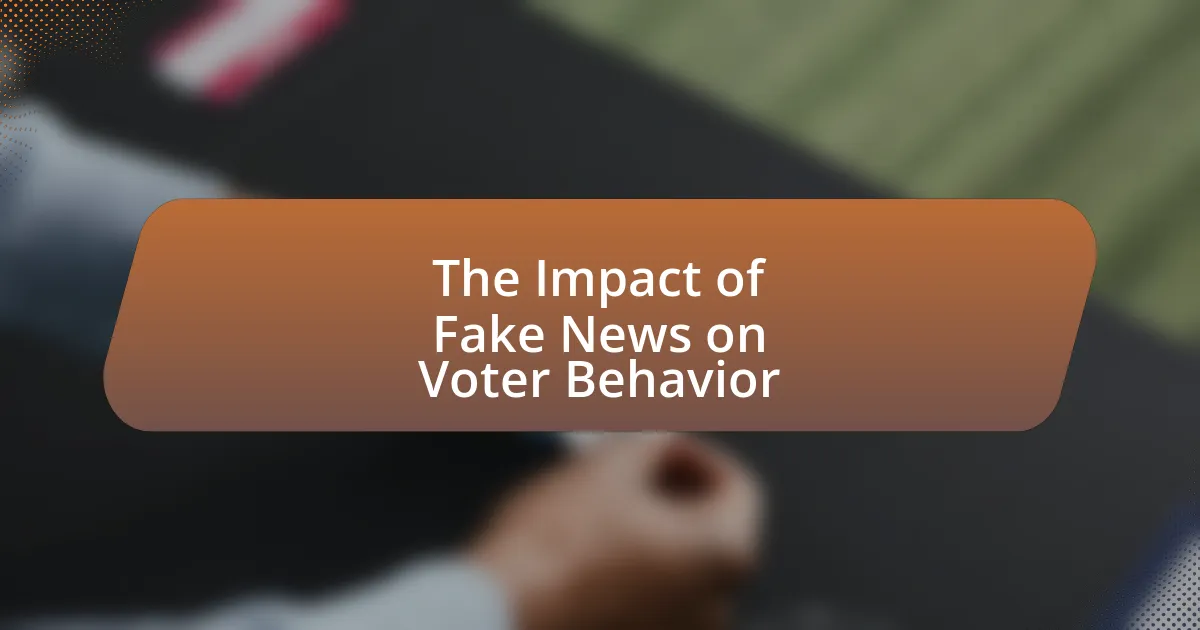The article examines the significant impact of fake news on voter behavior, highlighting how misinformation shapes perceptions and alters decision-making processes during elections. It discusses the psychological mechanisms affected by fake news, such as confirmation bias and cognitive dissonance, and how these factors contribute to voter polarization. The article also explores the role of social media in disseminating fake news, the prevalence of misinformation during elections, and the effectiveness of media literacy and fact-checking initiatives in combating its influence. Historical examples illustrate the consequences of fake news on electoral outcomes, emphasizing the need for voters to critically evaluate information sources to make informed decisions.

What is the Impact of Fake News on Voter Behavior?
Fake news significantly influences voter behavior by shaping perceptions and altering decision-making processes. Research indicates that exposure to misinformation can lead to increased polarization among voters, as individuals tend to align with narratives that confirm their pre-existing beliefs. A study published in the journal “Political Communication” found that individuals who encountered fake news were more likely to change their voting preferences, demonstrating the power of misleading information in swaying electoral outcomes. Furthermore, the spread of fake news can undermine trust in legitimate media sources, leading to a more misinformed electorate, which ultimately affects democratic processes.
How does fake news influence voter perceptions?
Fake news significantly influences voter perceptions by shaping beliefs and attitudes toward candidates and policies. Research indicates that exposure to misinformation can lead to distorted views, as individuals often rely on sensationalized or misleading information when forming opinions. For instance, a study published in the journal “Political Communication” found that voters exposed to fake news were more likely to hold negative perceptions of political opponents, impacting their voting decisions. This manipulation of information can create polarized views, ultimately affecting electoral outcomes and democratic processes.
What psychological mechanisms are affected by fake news?
Fake news primarily affects psychological mechanisms such as confirmation bias, cognitive dissonance, and social influence. Confirmation bias leads individuals to favor information that aligns with their pre-existing beliefs, making them more susceptible to accepting fake news that supports their views. Cognitive dissonance occurs when individuals encounter information that contradicts their beliefs, often resulting in the rejection of factual information in favor of misleading narratives. Social influence plays a significant role as individuals are affected by the opinions and behaviors of others, leading to the spread of misinformation within social networks. Research indicates that these mechanisms can significantly alter voter behavior by reinforcing partisan divides and shaping public opinion, as evidenced by studies showing that exposure to fake news can sway electoral outcomes by manipulating perceptions and attitudes.
How does fake news alter the way voters process information?
Fake news significantly alters the way voters process information by creating cognitive biases that distort their understanding of political issues. Research indicates that exposure to misinformation can lead to confirmation bias, where voters favor information that aligns with their pre-existing beliefs, thus reinforcing their views rather than challenging them. A study published in the journal “Science” by Vosoughi, Roy, and Aral in 2018 found that false news spreads more rapidly on social media than true news, affecting public perception and decision-making. This rapid dissemination of fake news can lead to misinformed voters who make choices based on inaccurate information, ultimately impacting electoral outcomes.
Why is understanding fake news important for elections?
Understanding fake news is crucial for elections because it directly influences voter perceptions and decisions. Misinformation can distort public opinion, leading to misguided voting choices and undermining the democratic process. Studies, such as one conducted by the Pew Research Center, indicate that 64% of Americans believe fabricated news stories cause confusion about the basic facts of current events, which can skew election outcomes. Furthermore, fake news can amplify polarization, as individuals are more likely to share sensationalized content that aligns with their beliefs, thereby affecting the overall electoral landscape.
What historical examples illustrate the impact of fake news on elections?
Historical examples that illustrate the impact of fake news on elections include the 2016 United States presidential election and the 1920 election in the United States. In the 2016 election, misinformation spread through social media platforms significantly influenced voter perceptions and decisions, with studies indicating that fake news stories were shared widely, affecting the electoral outcome. For instance, a study by the Pew Research Center found that 62% of Americans get news from social media, where false information proliferated. In the 1920 election, false claims about candidates, particularly regarding Warren G. Harding’s alleged extramarital affairs, were disseminated to sway public opinion, showcasing early instances of misinformation impacting voter behavior. These examples demonstrate how fake news can shape electoral results by manipulating public perception and voter engagement.
How does fake news contribute to voter polarization?
Fake news contributes to voter polarization by reinforcing existing biases and creating echo chambers among voters. When individuals consume misinformation that aligns with their pre-existing beliefs, it solidifies their viewpoints and increases their emotional investment in political identities. Research indicates that exposure to fake news can lead to heightened partisan animosity, as individuals become more entrenched in their positions and less willing to engage with opposing perspectives. A study by the Pew Research Center found that 64% of Americans believe that fake news has a significant impact on their political views, illustrating the pervasive influence of misinformation on voter behavior and polarization.

What are the sources of fake news affecting voters?
The sources of fake news affecting voters include social media platforms, partisan news outlets, and misinformation campaigns. Social media platforms, such as Facebook and Twitter, have been identified as significant channels for the rapid spread of false information, with studies showing that false news stories are 70% more likely to be retweeted than true stories. Partisan news outlets often present biased information that can mislead voters, contributing to polarization. Additionally, organized misinformation campaigns, often funded by political entities or foreign actors, aim to manipulate public opinion and disrupt electoral processes, as evidenced by the interference in the 2016 U.S. presidential election.
How do social media platforms facilitate the spread of fake news?
Social media platforms facilitate the spread of fake news by enabling rapid sharing and amplification of misleading information through user-generated content. The algorithms used by these platforms prioritize engagement, often promoting sensational or controversial posts, which can lead to the viral spread of false narratives. For instance, a study by the Massachusetts Institute of Technology found that false news stories are 70% more likely to be retweeted than true stories, highlighting the effectiveness of social media in disseminating misinformation. Additionally, the lack of stringent fact-checking mechanisms allows fake news to proliferate unchecked, further influencing voter behavior by shaping perceptions and opinions based on inaccurate information.
What role do algorithms play in promoting fake news content?
Algorithms play a crucial role in promoting fake news content by prioritizing engagement over accuracy. Social media platforms utilize algorithms that amplify sensational or emotionally charged content, which often includes fake news, because such content generates higher user interaction. A study by the Massachusetts Institute of Technology found that false news stories spread six times faster than true stories on Twitter, largely due to algorithmic preferences that favor viral content. This tendency leads to a distorted information landscape, influencing voter behavior by shaping perceptions and beliefs based on misleading narratives.
How do misinformation campaigns target specific voter demographics?
Misinformation campaigns target specific voter demographics by utilizing data analytics to identify and exploit the unique beliefs, values, and concerns of those groups. For instance, campaigns often analyze social media behavior, demographic information, and voting patterns to tailor messages that resonate with particular segments, such as younger voters or specific ethnic communities. Research indicates that targeted misinformation can significantly influence voter perceptions and behaviors; a study by the Pew Research Center found that 64% of Americans believe fabricated news stories cause confusion about the basic facts of current events, which can sway voter opinions and decisions.
What types of fake news are most prevalent during elections?
Misinformation and disinformation are the most prevalent types of fake news during elections. Misinformation involves the spread of false or misleading information without malicious intent, often through social media platforms, while disinformation is deliberately crafted to deceive voters, such as fabricated stories about candidates or voting procedures. A study by the Pew Research Center found that 64% of Americans believe fabricated news stories cause confusion about the basic facts of current events, particularly during election cycles. Additionally, a report from the Oxford Internet Institute highlighted that 70% of the most shared political content on social media during elections was misleading or false, underscoring the significant impact of these types of fake news on voter behavior.
What are the common themes found in election-related fake news?
Common themes found in election-related fake news include misinformation about candidates, false claims regarding voting procedures, and exaggerated or fabricated statistics about voter turnout or election integrity. Misinformation about candidates often involves distorted portrayals of their policies or personal lives, aiming to sway public opinion negatively. False claims regarding voting procedures can include misleading information about voter ID laws or deadlines, which can confuse or discourage voters. Exaggerated or fabricated statistics are frequently used to create a false narrative about the popularity of candidates or the legitimacy of the election process. These themes are prevalent in various studies, including the 2020 report by the Pew Research Center, which highlighted the significant impact of such misinformation on voter perceptions and behaviors.
How do different types of fake news affect voter behavior differently?
Different types of fake news affect voter behavior in distinct ways, primarily by influencing perceptions of candidates and issues. Misinformation that portrays a candidate negatively can lead to decreased voter support, as evidenced by studies showing that exposure to negative fake news correlates with lower favorability ratings for that candidate. Conversely, fake news that promotes a candidate or distorts facts in their favor can enhance voter enthusiasm and turnout, as seen in the 2016 U.S. presidential election, where pro-Trump misinformation circulated widely on social media, contributing to increased support among his base. Additionally, fake news that targets specific issues, such as immigration or healthcare, can polarize voters by reinforcing existing biases, leading to more extreme positions and reduced willingness to compromise. This dynamic illustrates how the nature of the fake news—whether it is negative, positive, or issue-focused—can shape voter attitudes and behaviors in varied and significant ways.

What strategies can mitigate the impact of fake news on voters?
To mitigate the impact of fake news on voters, implementing media literacy programs is essential. These programs educate voters on how to critically evaluate information sources, recognize misinformation, and discern credible news from false narratives. Research by the Stanford History Education Group found that students who received media literacy training were better equipped to identify misleading information online. Additionally, promoting fact-checking initiatives can help voters verify claims before sharing or acting on them, as demonstrated by the success of organizations like Snopes and FactCheck.org in debunking false information. Engaging social media platforms to enhance transparency and accountability in content moderation also plays a crucial role, as studies indicate that algorithmic adjustments can reduce the spread of false information.
How can media literacy improve voter resilience against fake news?
Media literacy can improve voter resilience against fake news by equipping individuals with critical thinking skills necessary to evaluate information sources effectively. When voters are trained in media literacy, they learn to discern credible news from misinformation, which is crucial in an era where 70% of Americans encounter fake news regularly, according to a Pew Research Center study. This training enables voters to question the validity of information, recognize bias, and seek out reliable sources, thereby reducing the likelihood of being misled by false narratives.
What educational programs are effective in teaching media literacy?
Educational programs that are effective in teaching media literacy include the Media Literacy Now initiative, which advocates for media literacy education in K-12 schools, and the News Literacy Project, which provides resources to help students discern credible information. Research indicates that programs like these enhance critical thinking skills and improve students’ ability to evaluate sources, thereby reducing susceptibility to misinformation. For instance, a study by the Stanford History Education Group found that students who participated in media literacy programs were significantly better at identifying credible news sources compared to those who did not receive such training.
How can critical thinking skills help voters discern credible information?
Critical thinking skills enable voters to evaluate the credibility of information by analyzing sources, assessing arguments, and identifying biases. These skills allow voters to differentiate between factual reporting and misinformation, which is crucial in an era where fake news can significantly influence public opinion and voter behavior. For instance, a study by the Pew Research Center found that individuals with strong critical thinking abilities are more likely to fact-check information and recognize misleading headlines, thereby making informed decisions at the polls.
What role do fact-checking organizations play in combating fake news?
Fact-checking organizations play a crucial role in combating fake news by verifying claims and providing accurate information to the public. These organizations assess the truthfulness of statements made by public figures, media outlets, and online content, thereby helping to reduce the spread of misinformation. For instance, a study by the Pew Research Center found that 64% of Americans believe that fact-checking helps them identify false information. By publishing their findings, fact-checkers not only inform the public but also hold media and political figures accountable, which is essential in maintaining an informed electorate, especially during elections.
How effective are fact-checking initiatives in changing voter behavior?
Fact-checking initiatives are effective in changing voter behavior, as evidenced by studies showing that exposure to fact-checks can reduce the likelihood of individuals believing false information. For instance, a study published in the journal “Political Communication” found that fact-checking significantly decreased the acceptance of misinformation among voters, particularly during election periods. Additionally, research from the Pew Research Center indicates that voters who engage with fact-checking content are more likely to adjust their opinions based on accurate information, demonstrating a direct correlation between fact-checking efforts and informed voting decisions.
What challenges do fact-checkers face in the current media landscape?
Fact-checkers face significant challenges in the current media landscape, primarily due to the rapid spread of misinformation and the increasing complexity of digital platforms. The prevalence of social media allows false information to circulate widely and quickly, making it difficult for fact-checkers to keep up. Additionally, the sheer volume of content generated daily complicates the verification process, as fact-checkers must sift through vast amounts of information to identify claims that require scrutiny. The rise of deepfakes and sophisticated disinformation tactics further complicates their efforts, as these technologies can create highly convincing false narratives. Furthermore, fact-checkers often encounter resistance from individuals and organizations that reject factual corrections, which can undermine their credibility and effectiveness.
What practical steps can voters take to avoid being misled by fake news?
Voters can avoid being misled by fake news by verifying information through credible sources before accepting it as true. This involves cross-referencing news articles with established fact-checking organizations such as Snopes or FactCheck.org, which provide evidence-based assessments of claims. Additionally, voters should scrutinize the credibility of the sources by checking the author’s qualifications and the publication’s reputation. Research indicates that individuals who engage in critical thinking and seek multiple perspectives are less likely to fall for misinformation, as shown in a study by Lewandowsky et al. (2012) published in “Psychological Science.” By actively questioning the validity of information and relying on reputable sources, voters can significantly reduce their chances of being influenced by fake news.
